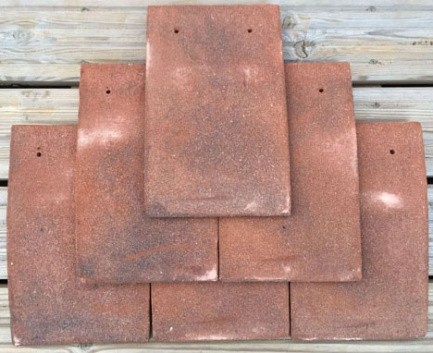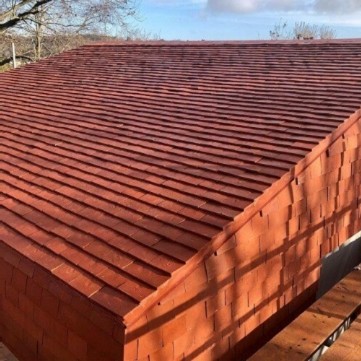Georgian Roof Tiles in Surrey
Heritage Tiles: Emblematic of the finest craftsmanship
Heritage tiles are the professional roofer's choice for the highest quality clay roof tiles. We pride ourselves in manufacturing, stocking, and delivering the very finest in prestige clay roof tiles.
Heritage Tiles have several tile ranges that satisfy every architectural requirement. Vintage and historic properties right up to modern new builds are covered by the diverse range of clay roof tiles that we stock.
So, whether you are in the building trade, or simply wish to choose your own tiles, Heritage Tiles have the right product for your specific requirements.
What Heritage Tiles have to offer our customers?
- We offer specification and technical solutions to help you achieve the perfect build.
- We also offer expert design advice to all our customers.
- We are happy to engage in site visits with our clients.
- We have stockists and distributors throughout the United Kingdom to ensure that we can provide our expert service to a wider area.
- We can provide estimated quantities from plans supplied by our clients.
- We offer battening plans.
- We can deliver a standard and bespoke colour choice for our clay tile products.
- All our tiles are assessed and approved by Lucideon.
- We provide a nationwide delivery and collection service.
The ranges of clay roof tiles we supply.
The Clayhall Range of roof tiles:

Clayhall Medium Blend - Carefully crafted to replicate all the features of handmade the Clayhall hand crafted range of tiles offers an excellent alternative when budget restrictions are a concern, but without compromising quality or durability.
Clayhall Dark Blend - Quality and durability in a budget clay roof tile. The Clayhall dark blend is sure to turn heads.
Clayhall Red Blend - A beautiful rustic clay roof tile. The Clayhall red blend is a firm favourite with our customers.
Clayhall Hamlet Mix - The Clayhall Hamlet mix is a gorgeous light and sandy looking clay roof tile that is a perennial favourite in the building trade.
Clayhall Birchwood Mix - The Clayhall Birchwood mix offers a gorgeous blend of lighter and darker shades in this diverse clay roof tile. If you are concerned that your roof tiles could look monotonous, the Clayhall Birchwood mix is the clay roof tile to choose.
The Conservation Range of roof tiles

The Conservation range of roof tiles are available in a range of distinctive colours, created by using a very fine sand, The Conservation Weathered; A natural warm tone, achieving an instant mellow and settled look and The Conservation Red; perfect for vertical tiling especially suited for villages and hamlets with olde world vernacular charm.
Manufactured using high quality clay, achieving high strength and durability properties, giving homeowners and contractors peace of mind for many years to come. The conservation range comes with a complete set of associated fittings, including Hog Back Ridge, Half Round Ridge, Bonnet Hips, Valley tiles and External Angles.
The Conservation range of clay roof tiles comes in the following variations:
- Conservation Red
- Conservation Weathered
- Conservation Dark
Conservation Peg Tile
Plain clay roofing tiles laid to a double lap have been used for roof covering in England since before the Norman Conquest and tiles dating back to Roman Times have been discovered under excavation. From the outset clay plain tiles were made incorporating fixing features.
The Classic Edwardian roof tile
The Classic range of plain tiles is one of the finest ranges of clay tiles.
We source only the best raw materials for our craftsman to create beautifully handmade clay tiles of the highest quality and durability.
Tile Fittings available from Heritage Tiles
There are many fittings that are available from us a Heritage Tiles to complete your build to perfection. We stock and supply the following:
- Gable Tile
- Eave Tile
- Baby Porch Ridge
- 90 Degree Ext. Angle
- Universal Bonnet Hip
- Half Round Ridge
- Hogs Back Ridge
- Mono Ridge
- Third Round Ridge
- Universal Valley
- Ornamental Club
- Bat Tile Set
Bat Tiles:
Provide help for our bats with our range of bat friendly roof tiles.
Did you know that all UK bats and their roosts are protected by law? The Wildlife and Countryside Act introduced in 1981, gave legal protection to all bat species and their roosts in England.
Distinct species of bats prefer differing places to roost. The two most usually found species of bat in the UK are the Pipistrelle and Brown Long-Eared Bat. Pipistrelle prefer confined spaces such as under tiles on roofs and hanging spaces. The Brown Long-Eared Bat prefer roof timbers and ridges inside lofts. Heritage Clay Tiles can provide purpose made access points within your roof tiles or ridge tiles. The Bat Tile Set can form part of a mitigation package required by law for existing roosts or as potential access where a roost had not previously been present.
Select a Blend
Getting the right blend for your roofing project can feel daunting, but with our blend generator you can mix and match various blends of tiles to achieve the perfect blend.
Click here to make use of our online tool to choose your own unique blend.
Because our strict quality control provides a consistent tile size you can mix assorted styles and colours of tiles to make your roof unique to you. Please use the tool below to experiment with various blends.
Adjust the sliders to set the ingredients for your desired blend then click on the update mix button.
Alternatively click on any blend or tile to display it.
Whatever type of clay roof tile you want, Heritage Tiles will be able to help.
Georgian Roof Tiles
Georgian perfection in our capital city
Only a short trip into the capital city and you will see some of the finest examples of Georgian architecture.
We supply a vast number of builders with roof tiles from our various ranges, but London builders and roofers always want a ready supply of our Georgian roof tiles because of the number of Georgian buildings in the capital.
An example of Georgian architecture in London.
International Students House in London is a fine example of Georgian architecture. The first building is at 1-6 Park Crescent. The entrance is actually at 229 Great Portland Street. When the students charity took the building over it was in a pretty bad state of repair and required renovation, including the roof being tiled with Georgian roof tiles to keep the original aesthetic of the building intact. It was opened in May 1965 by the Trusts Patron, Her Majesty Queen Elizabeth The Queen Mother. In 1968, a series of buildings designed by John Nash on York Terrace East also in the South Regents Park neighbourhood were also acquired, rebuilt and re-tiled. They were subsequently named Mary Trevelyan Hall and opened in 1971.
Georgian architecture outside London
The Circus is an important and historic ring of large townhouses in the city of Bath in Somerset. The Circus is a circle with three entrances. Designed by architect John Wood, the Elder, it was built between 1754 and 1768, and is regarded as a very fine example of Georgian architecture. The name comes from the Latin circus, meaning a ring, oval or circle. It has been designated as a Grade I listed building.
The Circus is divided into three segments of equal length, with a lawn in the centre. Each segment faces one of the three entrances, ensuring a classical facade is always presented straight ahead.
The need for a good supply of Georgian roof tiles is required for many building projects, but when a Georgian terrace property such as those detailed above require roofing, many hundreds of thousands of Georgian roof tiles are required.
As we handmake our Georgian roof tiles here at Heritage Clay Tiles Ltd, we always keep a very healthy stock of these specialist roof tiles. A renovation project on a Georgian terraced property in the city would require so many Georgian roof tiles, so it would not make good business sense to run our stocks of these tiles too low.
A little information about Surrey
Early Modern Surrey
Under the early Tudor kings, magnificent and luxurious royal palaces were constructed in northeastern Surrey, mainly because they were close to London. At Richmond an existing royal residence was rebuilt on a very grand scale under King Henry VII, who also founded a Franciscan friary nearby in 1499. The even more spectacular palace of Nonsuch was later built for Henry VIII near Ewell. The palace at Guildford Castle had fallen out of use long before, but a royal hunting lodge existed outside the town. Sadly all these glorious buildings have since been demolished.
Nonsuch palace
Nonsuch Palace, near Cheam in Surrey, was perhaps the grandest of Henry VIIIs building projects. It was built on the site of Cuddington, near Ewell, the church and village having been destroyed and compensation paid, to create a suitable site. Work started on 22 April 1538, the first day of Henry celebrated his thirtieth year on the throne, and six months after the birth of his son, later Edward VI.
Within two months the name Nonsuch appears in the building accounts, its name a boast that there was no such palace elsewhere equal to it in magnificence. Construction had been substantially carried out by 1541, but it took several more years to complete. As the Royal Household took possession of vast tracts of surrounding acreage, several major roads were re-routed or by passed to circumvent what became Nonsuch Great Park.
The palace was designed to be a celebration of the power and the grandeur of the Tudor dynasty, built to rival the Chateau de Chambord in France. Unlike most of the kings palaces, Nonsuch was not an adaptation of an old building; he chose to build a new palace in this location because it was near to one of his main hunting grounds. However the choice of location was unwise, as there was no nearby supply of water suitable for domestic use. The palace cost at least £24,000 because of its rich ornamentation and is considered a key work in the introduction of elements of Renaissance design to England.
The Cornish rebellion
During the Cornish Rebellion of 1497, the rebels heading for London briefly occupied Guildford and fought a skirmish with a government detachment on Guildown outside the town, before marching on to defeat at Blackheath in Kent. The forces of Wyatts Rebellion in 1554 passed through what was then northeastern Surrey on their way from Kent to London, briefly occupying Southwark and then crossing the Thames at Kingston after failing to storm London Bridge.
Early Surrey industry
Surrey had a cloth industry that had declined by the 16th century and collapsed in the 17th, damaged by falling standards and competition from more effective producers in other parts of England. The iron industry in the Weald, whose rich deposits had been exploited since prehistoric times, expanded and spread from its base in Sussex into Kent and Surrey after 1550. New furnace technology stimulated further growth in the early 17th century, but this hastened the extinction of the business as the mines were worked out. However, this period also saw the emergence of important new industries, centred on the valley of the Tillingbourne, south east of Guildford, which often adapted watermills originally built for the now moribund cloth industry. The production of brass goods and wire in this area was relatively short lived, falling victim to competitors in the Midlands in the middle of the 17th century, but the manufacture of paper and gunpowder lasted much longer. For a time in the middle of the 17th century the Surrey mills were the main producers of gunpowder in England. A glass industry also developed in the middle of the 16th century on the southwestern borders of Surrey, but had collapsed by 1630, as the wood fired Surrey glassworks were surpassed by emerging coal fired works elsewhere in England. The Wey Navigation, opened in 1653, was one of Englands first canal systems.
Surrey resident as Archbishop of Canterbury
George Abbot from Surrey, served as Archbishop of Canterbury in 1611 to 1633. In 1619 he founded Abbots Hospital, an almshouse in Guildford, which is still operating to this day. He also made unsuccessful efforts to revitalise the local cloth industry. One of his brothers, Robert, became Bishop of Salisbury, while another, Maurice, was a founding shareholder of the East India Company who became the company Governor and later the Lord Mayor of London.
Southwark expanded rapidly in this period, and by 1600, if considered as a separate entity, it was the second largest urban area in England. Parts of it were outside the jurisdiction of the government of the City of London, and as a result the area of Bankside became Londons principal entertainment district, since the social control exercised there by the local authorities of Surrey was less effective and restrictive than that of the City authorities. Bankside was the scene of the golden age of Elizabethan and Jacobean theatre, with the work of playwrights including William Shakespeare, Christopher Marlowe, Ben Jonson and John Webster performed in its playhouses.
Surrey in the English Civil War
Surrey almost entirely escaped the direct impact of fighting during the main phase of the English Civil War in 1642 to 1646. The local Parliamentarian gentry led by Sir Richard Onslow were able to secure the county without difficulty on the outbreak of war. Farnham Castle was briefly occupied by the advancing Royalists in late 1642, but was easily stormed by the Parliamentarians under Sir William Waller. A new Royalist offensive in late 1643 saw skirmishing around Farnham between Wallers forces and Ralph Hoptons Royalists, but these brief incursions into the western fringes of Surrey marked the limits of Royalist advances on the county. At the end of 1643 Surrey combined with Kent, Sussex and Hampshire to form the South Eastern Association, a military federation modelled on Parliaments existing Eastern Association.
In the uneasy peace that followed the Royalists defeat, a political crisis in summer 1647 saw Sir Thomas Fairfaxs army pass through Surrey on their way to occupy London, and subsequent billeting of troops in the county caused considerable upset with the local population. During the brief Second Civil War of 1648, the Earl of Holland entered Surrey in July, hoping to ignite a Royalist revolt. He raised his standard at Kingston and advanced south, but found little support. After confused manoeuvres between Reigate and Dorking as Parliamentary troops closed in, his force of five hundred men fled north and was overtaken and beaten at Kingston.
Early politics seated in Surrey
Surrey had a central role in the history of the radical political movements unleashed by the civil war. In October 1647 the first manifesto of the movement that became known as the Levellers, The Case of the Armie Truly Stated, was drafted at Guildford by the elected representatives of army regiments and civilian radicals from London. This document combined specific grievances with wider demands for constitutional change on the basis of popular sovereignty. It formed the template for the more systematic and radical Agreement of the People, drafted by the same men later that month. It also led to the Putney Debates shortly afterwards, in which its signatories met with Oliver Cromwell and other senior officers in the Surrey village of Putney, where the army had established its headquarters, to argue over the future political constitution of England.
Products available from Heritage Clay Tiles Ltd in East Sussex
Clay Roof Tiles in East Sussex
Clayhall Roof Tiles in East Sussex
Conservation Roof Tiles in East Sussex
Edwardian Roof Tiles in East Sussex
Victorian Roof Tiles in East Sussex
Georgian Roof Tiles in East Sussex
Handmade Clay Tiles in East Sussex
Handmade Roof Tiles in East Sussex
High Quality Roof Tiles in East Sussex
Traditional clay tiles in East Sussex
Traditional roof tiles in East Sussex
Products available from Heritage Clay Tiles Ltd in Essex
Conservation Roof Tiles in Essex
High Quality Roof Tiles in Essex
Traditional clay tiles in Essex
Traditional roof tiles in Essex
Products available from Heritage Clay Tiles Ltd in Hampshire
Clayhall Roof Tiles in Hampshire
Conservation Roof Tiles in Hampshire
Edwardian Roof Tiles in Hampshire
Victorian Roof Tiles in Hampshire
Georgian Roof Tiles in Hampshire
Handmade Clay Tiles in Hampshire
Handmade Roof Tiles in Hampshire
High Quality Roof Tiles in Hampshire
Traditional clay tiles in Hampshire
Traditional roof tiles in Hampshire
Products available from Heritage Clay Tiles Ltd in Hertfordshire
Clay Roof Tiles in Hertfordshire
Clayhall Roof Tiles in Hertfordshire
Conservation Roof Tiles in Hertfordshire
Edwardian Roof Tiles in Hertfordshire
Victorian Roof Tiles in Hertfordshire
Georgian Roof Tiles in Hertfordshire
Handmade Clay Tiles in Hertfordshire
Handmade Roof Tiles in Hertfordshire
High Quality Roof Tiles in Hertfordshire
Traditional clay tiles in Hertfordshire
Traditional roof tiles in Hertfordshire
Products available from Heritage Clay Tiles Ltd in Kent
Conservation Roof Tiles in Kent
High Quality Roof Tiles in Kent
Traditional clay tiles in Kent
Traditional roof tiles in Kent
Products available from Heritage Clay Tiles Ltd in London
Conservation Roof Tiles in London
Edwardian Roof Tiles in London
Victorian Roof Tiles in London
High Quality Roof Tiles in London
Traditional clay tiles in London
Traditional roof tiles in London
Products available from Heritage Clay Tiles Ltd in Surrey
Conservation Roof Tiles in Surrey
Edwardian Roof Tiles in Surrey
Victorian Roof Tiles in Surrey
High Quality Roof Tiles in Surrey
Traditional clay tiles in Surrey
Traditional roof tiles in Surrey
Products available from Heritage Clay Tiles Ltd in West Sussex
Clay Roof Tiles in West Sussex
Clayhall Roof Tiles in West Sussex
Conservation Roof Tiles in West Sussex
Edwardian Roof Tiles in West Sussex
Victorian Roof Tiles in West Sussex
Georgian Roof Tiles in West Sussex
Handmade Clay Tiles in West Sussex
Handmade Roof Tiles in West Sussex
High Quality Roof Tiles in West Sussex
Traditional clay tiles in West Sussex
Traditional roof tiles in West Sussex
Products available from Heritage Clay Tiles Ltd in Bedfordshire
Clay Roof Tiles in Bedfordshire
Clayhall Roof Tiles in Bedfordshire
Conservation Roof Tiles in Bedfordshire
Edwardian Roof Tiles in Bedfordshire
Victorian Roof Tiles in Bedfordshire
Georgian Roof Tiles in Bedfordshire
Handmade Clay Tiles in Bedfordshire
Handmade Roof Tiles in Bedfordshire
High Quality Roof Tiles in Bedfordshire
Traditional clay tiles in Bedfordshire
Traditional roof tiles in Bedfordshire
Products available from Heritage Clay Tiles Ltd in Berkshire
Clayhall Roof Tiles in Berkshire
Conservation Roof Tiles in Berkshire
Edwardian Roof Tiles in Berkshire
Victorian Roof Tiles in Berkshire
Georgian Roof Tiles in Berkshire
Handmade Clay Tiles in Berkshire
Handmade Roof Tiles in Berkshire
High Quality Roof Tiles in Berkshire
Traditional clay tiles in Berkshire
Traditional roof tiles in Berkshire
Products available from Heritage Clay Tiles Ltd in Buckinghamshire
Clay Roof Tiles in Buckinghamshire
Clayhall Roof Tiles in Buckinghamshire
Conservation Roof Tiles in Buckinghamshire
Edwardian Roof Tiles in Buckinghamshire
Victorian Roof Tiles in Buckinghamshire
Georgian Roof Tiles in Buckinghamshire
Handmade Clay Tiles in Buckinghamshire
Handmade Roof Tiles in Buckinghamshire
High Quality Roof Tiles in Buckinghamshire
Traditional clay tiles in Buckinghamshire
Traditional roof tiles in Buckinghamshire
Products available from Heritage Clay Tiles Ltd in Cambridgeshire
Clay Roof Tiles in Cambridgeshire
Clayhall Roof Tiles in Cambridgeshire
Conservation Roof Tiles in Cambridgeshire
Edwardian Roof Tiles in Cambridgeshire
Victorian Roof Tiles in Cambridgeshire
Georgian Roof Tiles in Cambridgeshire
Handmade Clay Tiles in Cambridgeshire
Handmade Roof Tiles in Cambridgeshire
High Quality Roof Tiles in Cambridgeshire
Traditional clay tiles in Cambridgeshire
Traditional roof tiles in Cambridgeshire
Products available from Heritage Clay Tiles Ltd in Oxfordshire
Clay Roof Tiles in Oxfordshire
Clayhall Roof Tiles in Oxfordshire
Conservation Roof Tiles in Oxfordshire
Edwardian Roof Tiles in Oxfordshire
Victorian Roof Tiles in Oxfordshire
Georgian Roof Tiles in Oxfordshire
Handmade Clay Tiles in Oxfordshire
Handmade Roof Tiles in Oxfordshire
High Quality Roof Tiles in Oxfordshire
Traditional clay tiles in Oxfordshire
Traditional roof tiles in Oxfordshire
Products available from Heritage Clay Tiles Ltd in Suffolk
Clayhall Roof Tiles in Suffolk
Conservation Roof Tiles in Suffolk
Edwardian Roof Tiles in Suffolk
Victorian Roof Tiles in Suffolk
Georgian Roof Tiles in Suffolk
Handmade Clay Tiles in Suffolk
Handmade Roof Tiles in Suffolk
High Quality Roof Tiles in Suffolk
Traditional clay tiles in Suffolk
Traditional roof tiles in Suffolk
Further Information
If you would like to know more or are interested in a quote we would be happy to help. Phone us on 01634 471 344, email us at sales@heritagetiles.co.uk and we will be in touch as soon as possible.







